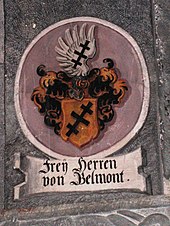Belmont Castle
| Belmont Castle | ||
|---|---|---|
|
Castle hill of Belmont Castle |
||
| Creation time : | around 1000 | |
| Castle type : | Höhenburg, rocky location | |
| Conservation status: | ruin | |
| Standing position : | Free nobles | |
| Place: | Flims | |
| Geographical location | 46 ° 50 '44 " N , 9 ° 20' 3" E | |
| Height: | 1420 m above sea level M. | |
|
|
||
The castle Belmont is the ruin of a rock castle northeast of Flims in the Swiss canton of Grisons with sight to the castle Crap Sogn Parcazi .
location
The facility is located at 1420 m above sea level. M. in the forest between Flims-Fidaz and Alp Bargis on a 50 m high cliff, high above the road from Trin to Flims. From the castle, the nearby Hohentrins as well as Hochjuvalt and Ortenstein in Domleschg were visible. The castle rock can be easily reached on foot in half an hour from a parking lot. The last ascent is via a steep path on the north side, the steps of which are partly cut into the rock.
investment
In 1930, according to Erwin Poeschel, only small remains of the wall were left of the entire complex. In the years 1932 to 1936 the ground plan was excavated and the remains of the wall secured.
The access leads via a bricked up ramp to a plateau with an extension of approx. 70 by 30 meters. An irregular circular wall stretches around it , against which the three main parts of the complex leaned. There was probably a gate in the west, perhaps with stables. The middle building complex, of which the remains of the wall can still be seen, consisted of a building measuring approx. 10 by 8 m with a door on each of the narrow sides and probably served as a dwelling.
The buildings in the east are made up of different parts that were erected in several phases and are no longer recognizable in detail. Remains of wall paintings were found in the southeastern room. Most of the superstructures were made of wood.
In the middle of the system is a large circular filter cistern . The small wall around it served as the foundation of a covered structure.
On the approximately 10 m higher part of the facility, a narrow rock rib approx. 30 m long and 10 m wide, no traces of a building can be seen, but it cannot be ruled out that a tower once stood there, possibly made of wood.
history
The oldest archaeological finds that can be dated, including a spike , date from the turn of the 10th and 11th centuries. It can be assumed that the oldest parts of the Belmont complex date from that time. Although there is evidence that the complex was inhabited into the 14th century, it was not significantly rebuilt after the middle of the 12th century. This suggests that the owners moved their headquarters to other castles.
Belmont was the ancestral home of the family of the same name, who belonged to the small circle of noble lords of the Vorderrhein Valley and owned goods in Flims, Vals and Lugnez . The name Belmont is the Latin / Romance version of the common name Schönenberg. The von Belmont appear in the documents for the first time in the Gamertinger contracts of January 22, 1139 as witnesses, a Lutefridus de Belmont is mentioned. With these contracts, the Bishop of Chur sealed the purchase of various goods in the Upper Engadine from the Counts of Gamertingen.
The barons of Belmont were related to the barons of Vaz , possibly also to the Taraspern . They put the diocese of Chur canons and with Konrad III. from Belmont 1273–1282 a bishop. The oldest named Rhaetian student at the University of Bologna was Heinrich von Belmont. With Ulrich Walter von Belmont, the family died out in 1371. Through his sister Adelheid, who was first married to Heinrich von Rhäzüns , part of the considerable inheritance went to her daughter Elisabeth von Rhäzüns, the wife of Caspar von Sax-Misox .
Belmont Castle was first mentioned in a document in 1380 on the occasion of an exchange of goods between Elisabeth von Rhäzüns and her cousin Brun von Rhäzüns. Elisabeth reserved the right to ... the buhel (hill) and daz burgstal ze Belmunt and daz gericht ze Flyms ... as well as all own people .. who belonged to the same burg ze Belmunt wilend ... The castle should have been abandoned at that time.
There are no indications of violent destruction, for example during the Belmont feud of 1352 or traces of fire. It is conceivable that an earthquake in 1356 or 1358 accelerated the decay of the castle. The complex was mentioned again in 1461: in an arbitration award across the border between Flims and Trin it said ... behind the burgstal Belmunt.
gallery
literature
- Otto P. Clavadetscher, Werner Meyer : The castle book of Graubünden . Zurich / Schwäbisch Hall, 1984











